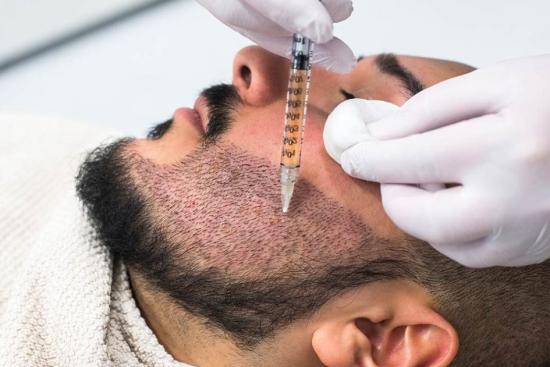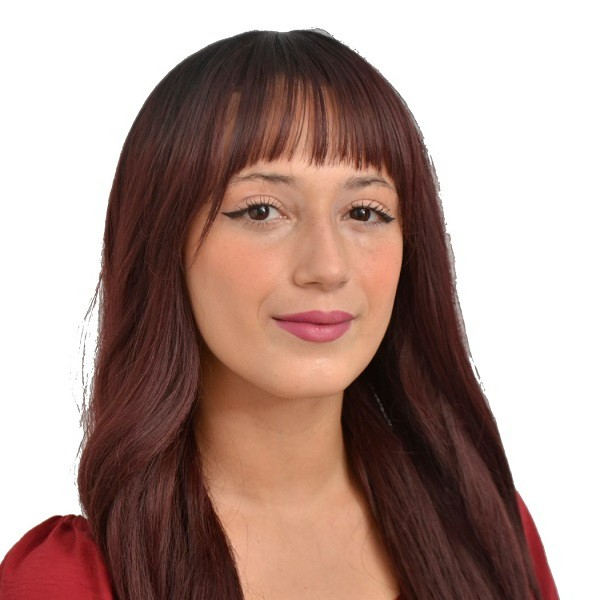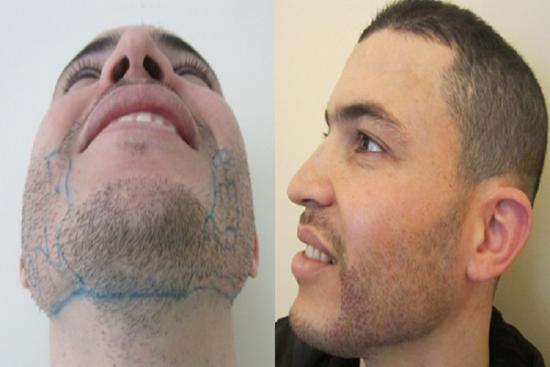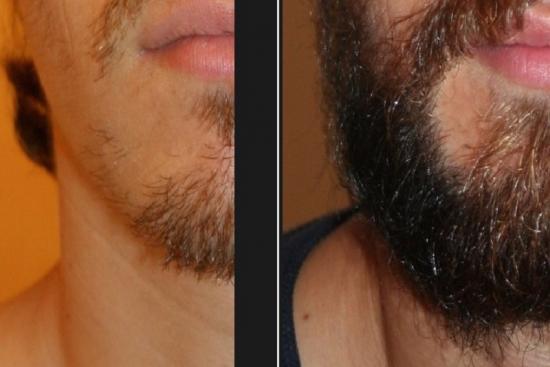The beard, a symbol of masculinity and style, has become an undeniable trend these days. However, not everyone is fortunate enough to enjoy dense, uniform facial hair. Fortunately, beard transplantation offers an effective solution for those who want a thick, well-defined beard.
- People with missing, uneven or fine beard hair.
- People wishing to hide facial scars.
- Pain.
- Bleeding.
- Infection.
- Swelling or redness of the scalp and/or beard area.
- Between 3 and 6 hours, depending on the number of grafts.
- Routine activities: 2 days after surgery.
- Back to work : 3 days.
- Back to sport: 1 month.
- Back to swim and steam baths: 1 month.
- 95%.
Beard and moustache transplantation cost in Turkey
Do you dream of a thick, well-defined beard? Turquie Santé offers beard and moustache transplant solutions at unbeatable prices, performed by internationally renowned plastic surgeons. With us, you'll benefit from first-class service and personalized attention at every stage of your transformation.
The average cost of a beard transplant in Turkey is around €1,600. For a personalized medical opinion, send us your file using the link below. You can also request a free, personalized quote to restore your facial hair.
Don't wait any longer for a perfect beard at an affordable price!
Best Clinics with Verified Reviews

- Multispecialized hospital
- 7 operating rooms
- Capacity é of 170 beds

- Multispecialized hospital
- Hospital founded in 2007
- Very good reputation in ENT department
Beard implant in Turkey: What is it?
Beard and moustache transplants are an innovative solution for men who want to significantly improve their appearance. Whether it is to thicken sparse hair, hide scars (acne, burns, surgery) or simply to assert a style, this procedure offers natural, long-lasting results.
Beard transplantation is a precision surgical procedure in which hair follicles are harvested from a donor area (usually the back of the neck) and meticulously implanted in specific areas of the face. This cutting-edge technique stimulates natural hair growth for undetectable, long-lasting results.
As an autologous procedure, beard transplantation uses your own follicles, eliminating the risk of rejection and ensuring perfect compatibility. Our team of expert surgeons in Turkey are masters of the various hair transplant techniques and perform each extraction and implantation with unrivaled precision.
Beard and moustache transplantation techniques: FUE, FUT or DHI?
If you're looking to improve the thickness or shape of your beard, there are several transplantation techniques to choose from. Each of these methods has its advantages and specific characteristics. Here's an overview of the three most popular techniques used for beard and mustache transplantation in Turkey:
FUE technique
FUE (Follicular Unit Extraction) is the most widely used technique and is appreciated for its precision. It involves the removal of follicles one by one without leaving visible scars. Minimally invasive and with fast healing, this method guarantees a natural result with minimal discomfort.
FUT technique
In the FUT (Follicular Unit Transplantation) technique, the doctor removes a strip of skin from the back of the head to extract the grafts. Although this method allows for many follicles to be harvested in a single session, it has a longer healing time and an increased risk of visible scarring.
DHI Gold Plus technique
DHI Gold Plus (Direct Hair Implantation) is a revolutionary advancement in beard transplantation. Developed in our partner clinics in Turkey, it allows for direct, ultra-precise implantation of grafts without shaving the head or beard. Thanks to a gold-tipped tool, the follicles are implanted with extreme precision, ensuring an even, natural result.
If you're looking for an effective, discreet solution with a quick recovery time, FUE or DHI Gold Plus are ideal choices. For those who wish to cover a larger area in a single procedure, FUT may be considered.
Need expert advice in Turkey? Contact us now for a free teleconsultation and personalized quote!

Preparations to avoid a botched beard transplant
Beard transplantation is the ideal solution for correcting scars, balancing hair density, and harmonizing lower facial features for a more groomed, natural appearance. But to ensure optimal success, rigorous preparation is essential. Here are our tips for avoiding a botched beard transplant and maximizing your chances of success.
Advance consultation
To avoid any risk of complications, a thorough consultation with the surgeon is essential. This should take place at least two weeks before surgery. During this consultation, the specialist will analyze your expectations and take photographs of the area to be treated. These photos are used to determine the number of hair follicles to be harvested, which generally varies between 500 and 3,000 grafts. This number of grafts will also affect the price of the beard transplant.
Importance of a blood test before the procedure
A pre-transplant blood test is essential to check your general health and ensure that you are fit to undergo the procedure. This will help minimize risks and ensure the success of the procedure.
Choosing an expert
The key to a successful beard transplant is choosing the right surgeon. Make sure your specialist has proven experience and expertise in the field to ensure a natural, harmonious result.
By following these steps and taking the proper precautions, you'll maximize your chances of a successful beard transplant and achieving the look you desire.
Ready to transform your beard? Contact one of our expert partners and get ready for a stunning result!
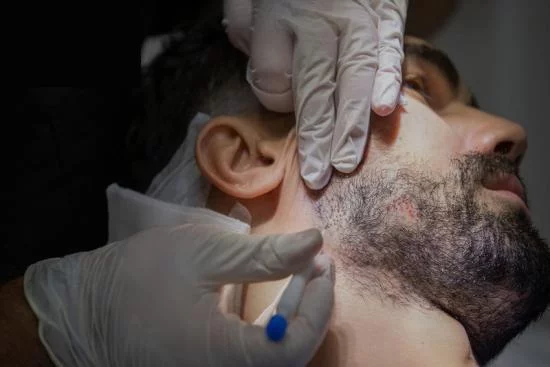
Procedure for beard implantation in Turkey
Beard implantation is performed under local anesthesia, which ensures that you will not feel any pain during the procedure. The anesthetic is injected directly into the beard and neck area, numbing the targeted areas so you'll feel completely comfortable.
The surgeon will begin by precisely marking the areas of your face that need correction and the area from which the hair follicles will be taken. Next, the follicles are carefully extracted and implanted in sparse or hairless areas, depending on the desired design.
Over weeks and months, the implanted follicles begin to produce new beard hairs. The first results are usually visible after a few months, and full hair growth takes between 6 and 12 months. This period of time is necessary for the beard to achieve its natural, dense appearance and provide a permanent, aesthetic change.
Post-operative advice
Here are the steps you should take to optimize the success of your beard and mustache transplant and avoid a bad experience:
- Elevate your head the first night by using several pillows or sleeping in a recliner. This may help reduce swelling.
- Place a clean towel under your head to absorb any minor bleeding.
- Avoid drinking alcohol during the recovery period to promote optimal healing.
- Avoid swimming or wetting the grafted area with chlorinated or salty water during the initial recovery period.
- Avoid applying cosmetic products to the grafted area without the prior approval of your surgeon. Some products may contain ingredients that can interfere with healing.
By following these tips, you will maximize your chances of achieving a natural, long-lasting result. A successful beard transplant depends not only on your surgeon's expertise, but also on your involvement during the recovery period. Take care of yourself and follow the instructions carefully to avoid any unpleasant surprises.
Share this page
Among our doctors for your Beard transplant
Beard grafting is a definitive procedure if it's carried out in good practice, with a competent plastic surgeon. Therefore, it is recommended to resort to accredited clinics in cosmetics to ensure the durability of the implant.
You can use chevus mower after one month of the transplant, keeping the hair at least 3 mm long. However, direct shaving with a razor is not recommended until one year after the transplant.
Complications and side effects after beard transplant are rare. Some minor complications may occur, such as:
- Infection.
- Telogen Effluvium: Loss of beard hair may occur in areas close to the transplanted areas.
- Edema and ecchymosis: they can last from 4 to 7 days.
- Poor growth.
For beard transplant, you need to follow some criteria. This is because the hormones, that make facial hair strong and resistant, must reach a certain level. Experts consider the ideal age for beard transplantation to be a minimum of 20 years old.
Thanks to the use of high-quality equipment and the FUE "punch" technique, the surgery leaves no marks or scars.
